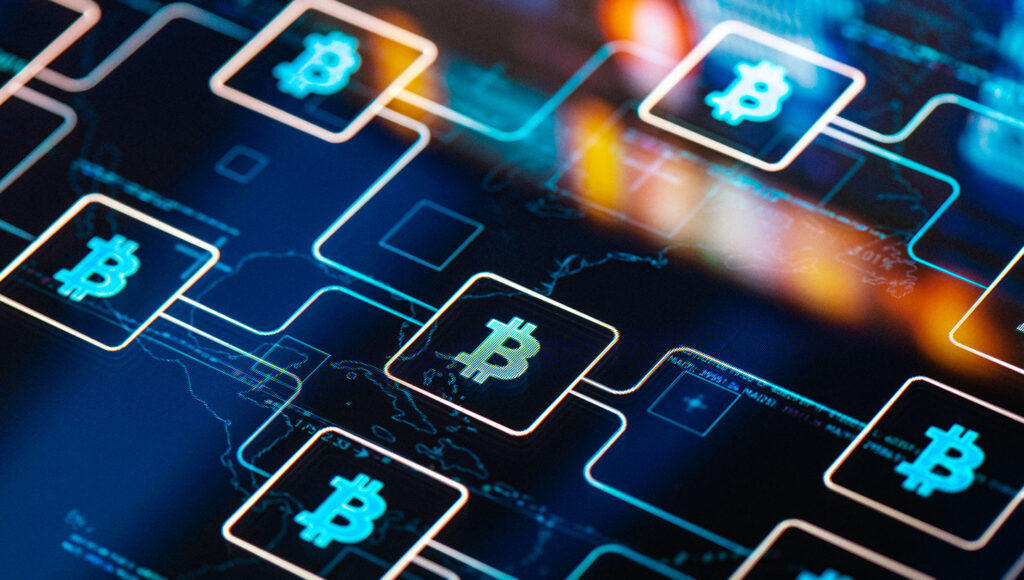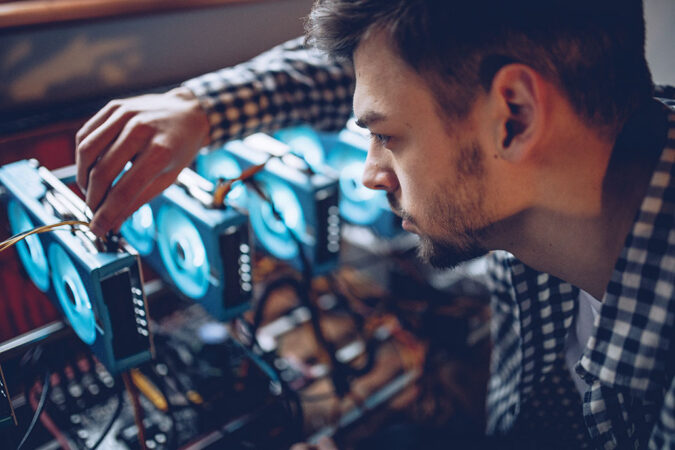‘Mining’ cryptocurrencies pollutes the real world
Bitcoin and other virtual currencies use vast amounts of energy and create lots of waste

Bitcoin is a type of virtual money, meaning it exists only as data that are stored and moved by computers. The computers that move this and other types of cryptocurrency can use a lot of energy and other resources, with high environmental costs.
da-kuk/E+/Getty Images Plus
Bitcoin and other so-called cryptocurrencies exist only online. Yet this virtual money has real-world environmental costs. Indeed, the impacts of virtual currencies are higher than for any other type of money, studies now show.
The prefix “crypto-” comes from the Greek word for “hidden” or “secret.” (It’s the same prefix in “cryptography.” That’s the study of codes and other secure communications.)
Governments or central banks have traditionally issued more conventional types of money. Those institutions set the face value of this money. They also control its supply. In contrast, there is no central authority for Bitcoin and other cryptocurrencies. And digital currencies have no set value.
“The only value in Bitcoin is the perceived value that people are willing to pay,” explains smart-card expert Uwe Trüggelmann. He heads TruCert Assessment Services. It’s in Nanaimo, British Columbia. That lack of a fixed value, he notes, poses financial risks to people who buy Bitcoin or other cryptocurrencies.
With no government in charge, each cryptocurrency uses a spread-out network of computer users. Each network keeps track of all the transactions done using its currency. Each batch of new transactions makes up what’s known as a new block. Each block gets added to a long ledger of data. The string of data in that virtual ledger is called a blockchain.
Rules for each cryptocurrency control who can add new blocks to a blockchain. Bitcoin and some other types use rules called “proof of work.” Algorithms provide an ever-harder series of online math problems. People in the network then compete to solve them.
As these problems got harder, many competitors began using machines that make fast random guesses to solve the puzzles.
So, “you first have to play a guessing-numbers game,” explains Alex de Vries. Based in Almere, the Netherlands, de Vries is the founder and head of Digiconomist. “Only those that guess correctly get to add a new block to the blockchain,” he says — “and get a reward.” With Bitcoin, for example, that reward has two parts. One is the fee for the transactions on the new block. The other is some new Bitcoin. Hence, the correct guesser’s work is referred to as “mining” Bitcoin.
The computer work behind that mining is data-intensive. It also uses a lot of resources. This explains its high environmental costs. Those costs remain largely invisible to users. But they have very real — and visible — impacts.
Energy hogs
Cryptocurrency computations rely on “a lot of very real machines that use a lot of very real electricity,” de Vries notes. Their number-crunching takes place in data centers that use lots of specialized computers. This equipment runs constantly. As a result, it uses huge amounts of energy. Bitcoin’s system alone uses more energy than some countries, such as the Netherlands, the Czech Republic or Chile.
Cryptocurrency miners buy the electricity they use. And most of that electricity comes from fossil fuels. Prices for coal and petroleum are much lower than they should be. That’s because those industries have gotten government help (known as subsidies). Also, the prices people pay for fossil fuels don’t reflect all of the impacts from pollution. Burning those fuels emits greenhouse gases, which can warm Earth’s climate. Pollution from fossil fuels can also harm human health. But fossil-fuel companies don’t pay those costs.
Researchers at the University of New Mexico in Albuquerque recently tallied costs for pollution from Bitcoin. As of 2018, each $1 of value created from Bitcoin mining done in the United States led to health and climate-damage costs worth an estimated $0.49. That’s about half the value of the Bitcoin that was mined. The team shared its work in the January 2020 issue of Energy Research & Social Science.
Competition among miners drives up that energy use. As of May 2021, computers in the Bitcoin-mining network made about 180 quintillion guesses every second. (That’s 18 followed by 19 zeroes). Each bitcoin sold for about $36,000 that month. By the start of December 2021, that selling price had climbed to about $57,000. So mining businesses had even more incentive to compete.

Newer and newer computers
The special computers and equipment that mining businesses employ use aluminum, copper, iron, silicon and other materials. That means cryptocurrency mining requires real-world mining as well, notes Christina Cogdell. She’s a cultural historian at the University of California, Davis. Her studies focus on how energy, materials and design have changed over time.
Mining raw materials and making computers uses energy and creates waste. Both contribute to pollution, she notes. And with keen competition, cryptocurrency miners replace their computers with newer models often. The old ones — and the raw materials that went into them — become trash.
Each year, now, the Bitcoin network produces about as much electronic waste as the whole country of Luxembourg, de Vries and others report. Put another way, each Bitcoin transaction produces roughly 135 grams (4.8 ounces) of electronic waste. That’s about the weight of an iPhone 12 mini. That waste is generally not recycled. It just goes into landfills.
“Electronic waste contains a bunch of toxic materials that leach into the ground and groundwater,” de Vries explains. If the waste is burned, pollutants go into the air. “All those toxic materials that get into the groundwater or the air are just really bad for human health,” he says. Worst of all, he adds, most of this pollution harms people who don’t profit from cryptocurrencies.
Energy used for cryptocurrency mining also can lessen the stability of the electric grid. And the constant need for new computers can worsen shortages of other devices that use computer chips. De Vries and his colleagues shared their findings in One Earth in June 2021 and in Resources, Conservation and Recycling in December 2021.
Not all cryptocurrencies use proof-of-work systems, as Bitcoin does. Some use a proof-of-stake system. Here, network users with more of a cryptocurrency get to approve more new blocks than those with smaller stakes. The user who adds each new block collects fees for transactions in that bunch of data. And those who cheat risk losing their stake.
Ether is a cryptocurrency managed by a network known as Ethereum. This network plans to switch to proof-of-stake sometime this year. Under the older proof-of-work system, Ether mining used about as much energy as the entire nation of New Zealand. The switch could cut Ethereum’s energy use by about 99 percent, the Washington Post reported in November 2021.
Meanwhile, mining for Bitcoin and other cryptocurrencies continues to add to global pollution. “Ultimately,” says de Vries, “it’s about the overall health of our planet.”
Bitcoin electrical use, by the numbers
The global Bitcoin network uses a lot of electricity. How much? By February 2022, it needed 14.37 gigawatts of electricity generation. That’s according to the University of Cambridge Bitcoin Electricity Consumption Index. It was enough electricity to power nearly 14.4 million typical U.S. homes.
That translates to nearly 126 terawatt-hours — trillion watt-hours — of electricity for a year. The price of electricity varies by region. U.S. rates during 2021 averaged 10.6 cents per kilowatt-hour. At that rate, Bitcoin’s yearly power consumption might have collectively cost almost $13.4 billion! And that cost doesn’t include environmental impacts.







